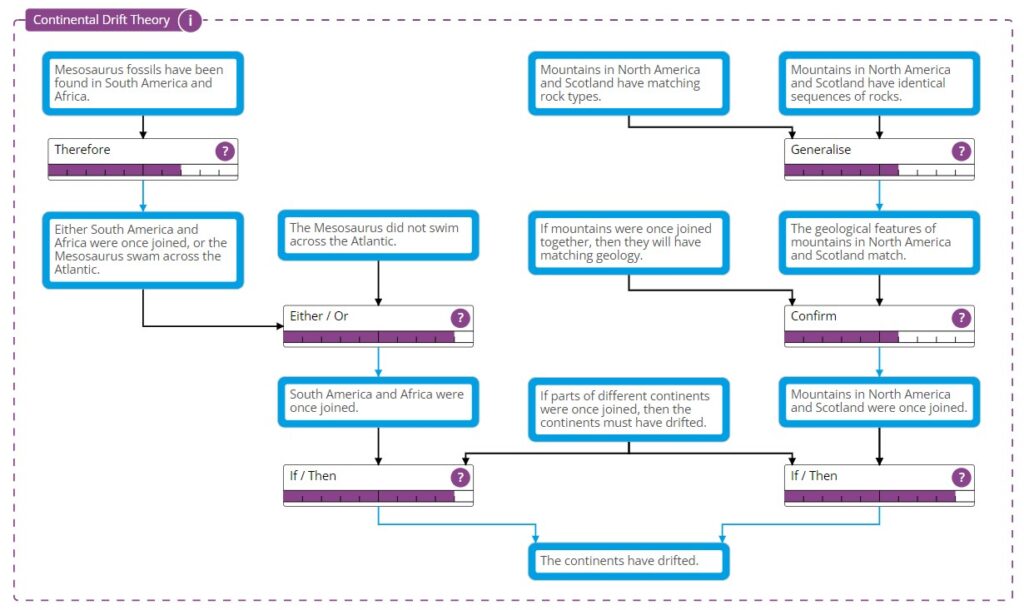23 Feb How Dual Coding Helps Students to Understand Arguments
This article discusses the theory of dual coding and how it makes argument mapping an effective way of displaying arguments. If you need a reminder, click here to read our blog on dual coding first, or click here to learn about our argument graphs.
The Components of an Argument Graph
In our previous blog post, we discussed how dual coding theory argues that we process verbal and non-verbal information separately, using two different cognitive systems. Argument graphs follow dual coding theory, by displaying information verbally and non-verbally to make arguments easier to understand.
Argument mapping uses a combination of simple statements and symbols such boxes and arrows to display an argument as a diagram, which we call an argument graph. In this case, the statements are the verbal components, while the boxes and arrows are non-verbal (Figure 1). The boxes contain the statements and the arrows show a relationship between different statements, which help to build the argument toward its conclusion.

Figure 1: The verbal and non-verbal elements of an argument graph.
Let’s take a look at an example of how verbal and non-verbal information is combined to make an argument graph about continental drift.

Figure 2: An argument graph about continental drift theory. The graph is made up of two different branches: the first branch discusses fossil evidence; the second, geological evidence.
Compared to an original source comprising paragraphs of argumentative text, an argument graph from Endoxa Learning uses dual coding to make it easier to learn (Figure 2). The main verbal components are the statements which participate in the argument, e.g. “the Mesosaurus did not swim across the Atlantic” Any other text which might be present in the original text is discarded or relegated to annotated notes. Argument type labels can also be used to help students understand how each step of the argument works, such as “because” or “either/or”. The non-verbal components are the boxes, the arrows and the overall layout. The boxes use colour to show whether statements are true or false. The argument itself is displayed visually, by using the boxes and the arrows that connect them. The arrows represent logical relations between the different statements, connecting premises with a conclusion and one step of the argument to the next. The overall layout of the argument graph shows the branched structure of the argument graph, with the two branches flowing to the final conclusion, “the continents have drifted”. Importantly, the student can see that this argument is based on two lines of reasoning:
-
- Fossils
- Mountains
Furthermore, argument graphs from Endoxa Learning follow each of Caviglioli’s design principles for dual coding: Only essential information is included; sections of the argument are grouped into chunks; the different chunks are aligned to make it easier to read; and the design is simple, without too much colour. These characteristics mean that the argument graph doesn’t require too much cognitive load.
The Benefits of an Argument Graph
Making the structure of arguments explicit is useful and important, because when arguments are written as prose, students do not recognise arguments in text. Instead, they read the text “as if it were a story”. This is because arguments in text are often inexplicit and need to be inferred by the reader. On the other hand, an argument graph makes the flow of an argument explicit through the use of symbols and colours. As a result, students no longer need to work out how each statement is connected, because these relationships are explicit. This means that the student can learn the argument more easily. Most importantly, it means the student can see how a good argument is constructed and will be able to apply the same rules to their own work, avoiding unimportant information and poor structures.
Furthermore, experts have found that critical thinking skills are improved when students use argument mapping. Two principles underpin the theory that argument mapping improves critical thinking.
-
- Dual coding through the use of words and diagrams makes it easier to process complex information.
- We can take in “complex arguments” more effectively if some of the information is in a diagrammatic format.
Essentially, the benefits of dual coding apply to learning arguments, so if we display arguments using a combination of text and diagrams, students will be able to understand and learn those arguments more effectively. In turn, we argue that this helps them to think critically and construct their own well-reasoned arguments.
Click here to learn how our lessons work.
If you’re interested in learning more about dual coding and argument mapping, see our longer article for further explanation and a selection of academic references.


